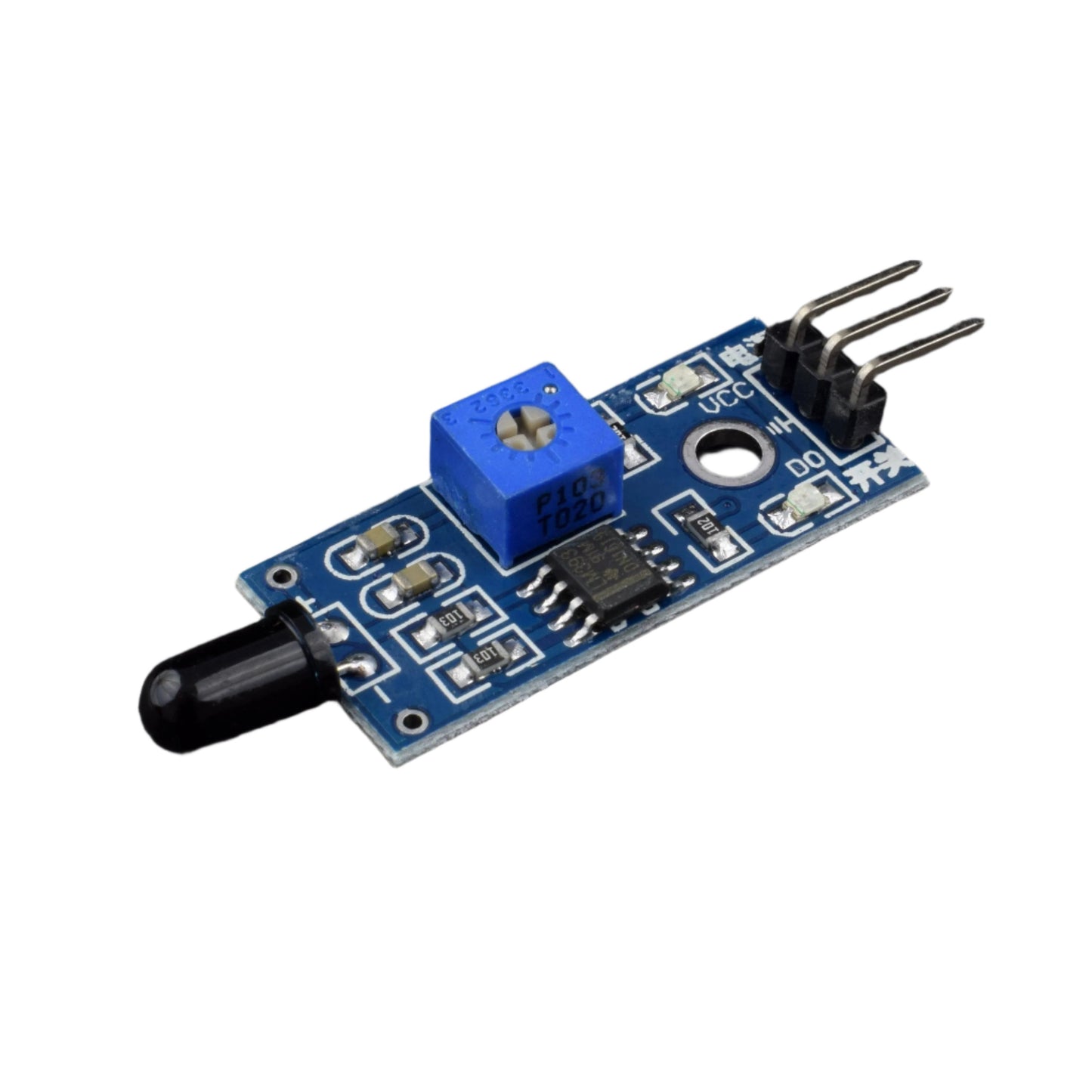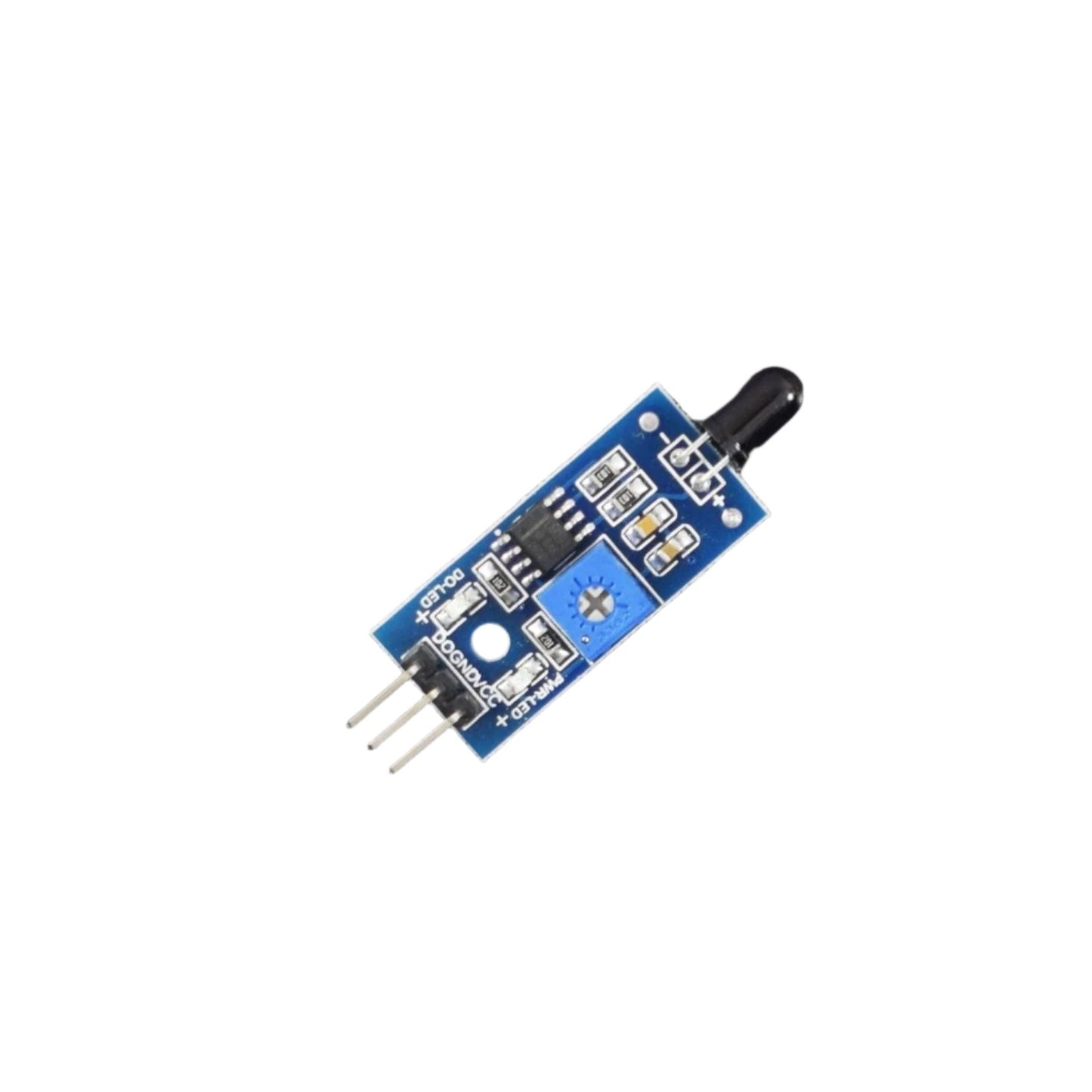

- Working voltage: 3.3v - 5v
- Detect range: 60 degrees
- Digital/Analog output
- On-board LM393 chip
Description:
Great for fire alarms, can detect the flame/wavelength at 760 nm to 1100 nm range of the light source. The distance of the test flame lighter: is 80cm. The larger the flame is, the larger the distance test. The detection angle is 60 degrees, and the flame spectrum is especially sensitive. Adjustable sensitivity, it is shown in blue digital potentiometer adjustment. The output signal waveform of the comparator is clean and good, driving ability: is more than 15mA
Specification:
- Working voltage: 3.3v - 5v
- Detect range: 60 degrees
- Digital/Analog output
- On-board LM393 chip
Features:
- High Photo Sensitivity
- Fast Response Time
- Sensitivity adjustable
Usage:
These types of sensors are used for short-range fire detection and can be used to monitor projects or as a safety precaution to cut devices off / on.
Range:
accurate up to about 3 feet
How it works:
The flame sensor is very sensitive to IR wavelength at 760 nm ~ 1100 nm light.
Analogue output (A0): Real-time output voltage signal on the thermal resistance.
Digital output (D0): When the temperature reaches a certain threshold, the output high and low signal threshold adjustable via the potentiometer.
Pin Description:
VCC: Positive voltage input: 5v for analogue and 3.3v for Digital.
A0: Analog output
D0: Digital output
GND: Ground
Testing:
To test the Flame Sensor and ensure that it is working correctly connect the VCC to a 5v power source and GND. Move a flame source within a foot of the front of the Ir sensor and the D0-LED should light up.
Troubleshooting:
If the D0-LED does not light up check the following:
- Is the power source 5v?
- Is the ground hooked up?
- Is the flame within 1 foot and in Line of Sight?
If none of the previous makes the D0-LED light up, your sensor may be defective.
How to Upload the Code:
To wire the Flame Sensor to the Arduino simply connect the following as shown:
Flame sensor ............... Arduino
VCC............................... 5v
GND...............................GND
A0.................................. Analog in
Code
The following code maps and reads the analog values given by the flame sensor (0-1024). The stock flame sensor will have the following reaction with this code:
- If holding a flame within 1.5 feet in front of the sensor; "case 0" will be activated and " ** Close Fire ** " will be sent to the serial monitor.
- If holding a flame between 1.5 feet and 3 feet in front of the sensor; "case 1" will be activated and " **Distant Fire** " will be sent to the serial monitor.
- If no flame is detected in front of the sensor; "case 2" will be activated and " No Fire " will be sent to the serial monitor.
* To view the output, point a serial monitor such as Putty at your Arduino.
* This code is constantly updating in order to provide real-time feedback of the flame sensor.
/* Flame Sensor analog example*/
// lowest and highest sensor readings:
const int sensorMin = 0; // sensor minimum
const int sensorMax = 1024; // sensor maximum
void setup() {
// initialize serial communication @ 9600 baud:
Serial.begin(9600);
}
void loop() {
// read the sensor on analog A0:
int sensorReading = analogRead(A0);
// map the sensor range (four options):
// ex: 'long int map(long int, long int, long int, long int, long int)'
int range = map(sensorReading, sensorMin, sensorMax, 0, 3);
// range value:
switch (range) {
case 0: // A fire closer than 1.5 feet away.
Serial.println("** Close Fire **");
break;
case 1: // A fire between 1-3 feet away.
Serial.println("** Distant Fire **");
break;
case 2: // No fire detected.
Serial.println("No Fire");
break;
}
delay(1); // delay between reads
}
How To Use:
Make a Flame Detection System using Flame Sensor Module
Package Included:
1 x IR Infrared Flame Sensor
Note
- Please maintain a certain distance between the sensor and the flame, so as not to damage the sensor.
- The higher accuracy would get in the conversion process of small plates analog output mode and the AD.




